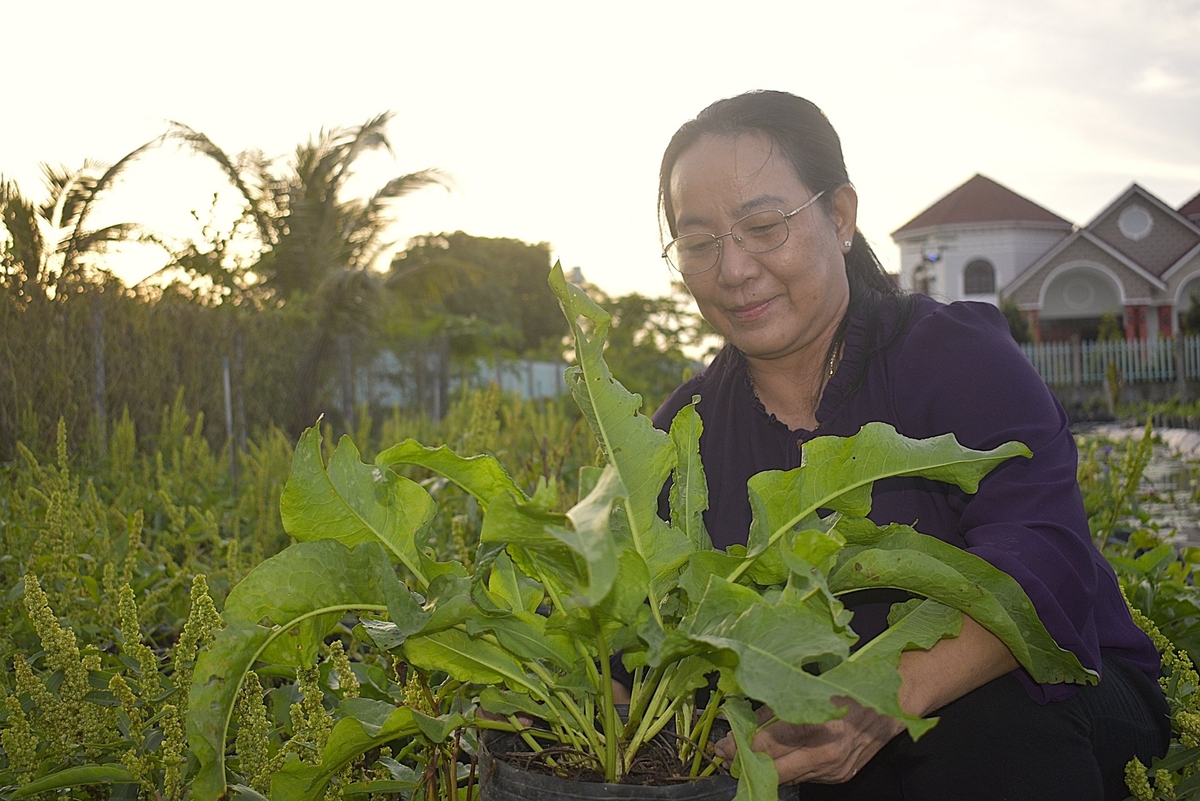November 21, 2025 | 01:32 GMT +7
November 21, 2025 | 01:32 GMT +7
Hotline: 0913.378.918
November 21, 2025 | 01:32 GMT +7
Hotline: 0913.378.918
On July 31, 2025, the Department of Crop Production and Plant Protection (Ministry of Agriculture and Environment) approved the self-declaration of circulation for a new plant variety and published the information on its official portal for Queen curly dock (red ginseng). This is the latest medicinal plant, scientifically named Rumex crispus L., authorized for nationwide circulation.
The Queen ginseng plant was developed by Prof. Dr. Vo Thi Ngoc, a globally recognized scientist and Director of Ms Thien Ngoc Food Co., Ltd. (Vinh Long). She is the principal author and received approval from the Department of Crop Production and Plant Protection for the plant variety protection application in 2022.

Prof. Dr. Vo Thi Ngoc is a leading researcher on the Queen ginseng. Photo: Minh Dam.
Analysis conducted by the Institute of Medicinal Materials, the National Institute for Food Safety Testing (Ministry of Health), and the CASE Laboratory revealed that the Queen curly dock (Rumex crispus L.) also referred to as "Queen ginseng" (or Queen Red Ginseng). It possesses an impressive chemical composition.
The roots contain 2.3% total saponins, 14.4% polysaccharides, 13.6% polyphenols, and 0.4% flavonoids. The leaves are even richer, with 7.4% saponins, 7% polysaccharides, 14.4% polyphenols, and 0.5% flavonoids. In addition, both roots and leaves are abundant in vitamin C, vitamin K, phosphorus, and amino acids.
A key distinction is that “Queen ginseng” does not contain ginsenosides, the signature compounds of the Panax genus (such as Ngoc Linh ginseng or Korean ginseng). Instead, it excels in its high levels of polysaccharides, polyphenols, and flavonoids – three groups of compounds with strong antioxidant capacity, cardiovascular protection, and immune-boosting properties. This unique profile serves as the fingerprint that defines the identity of this medicinal plant.
Modern research indicates that the bioactive groups in this species can be developed into a wide range of products, including: Functional foods (dried herbal teas, polyphenol extract capsules, energy-boosting beverages), Cosmeceuticals (moisturizing creams, anti-aging serums, skincare products), Supportive pharmaceuticals (endurance enhancers, recovery aids for post-illness care, and specialized supplements for the elderly).

Ms. Vo Thi Ngoc was awarded the title of Honorary Professor by the American International University for her research on the Queen plant. Photo: Courtesy of the scientist.
Compared to imported ginseng, the advantage of “Queen ginseng” lies in its shorter growth cycle, lower cost, and domestic sourcing. It is close to every household, like a highly nutritious vegetable where both leaves and roots can be consumed daily, while also offering the potential to develop abundant raw material areas under various climatic conditions.
While dried Ngoc Linh ginseng can cost as much as VND 80–100 million/kg, and Korean ginseng ranges from VND 4–6 million/kg with long growth cycles, “Queen ginseng” has strong potential for large-scale cultivation. It can supply factories extracting valuable bioactive compounds for the pharmaceutical industry, making it competitive in domestic and export markets.
Vietnam has many ecological zones suitable for cultivating “Queen ginseng,” particularly in northern mountainous provinces and parts of the Central Highlands. Planning and developing production areas within a closed value chain, from seed supply, cultivation, harvesting, and processing, will ensure stable yields, consistent quality, and transparent traceability.
“Queen ginseng” has the potential to become a crop that helps many farming households escape poverty. However, turning this into reality requires joint efforts from the State, businesses, and scientists.
If developed in the right direction, Vietnam can absolutely position “Queen ginseng” as a flagship product on par with major global ginseng brands. This would enhance agricultural economic value, contribute to poverty reduction and wealth creation for farmers, and affirm the standing of Vietnamese medicinal herbs on the world map.
"Queen ginseng" has a growth cycle of 12–18 months. With a planting density of 3,000 plants per hectare, yields reach 1.6–2.4 tons/ha at 12 months after planting, and 2.9–5.6 tons/ha at 16–18 months.
Ms Thien Ngoc Food Co., Ltd. (Vinh Long) has established six nurseries for this ginseng variety in Dong Thap, Ho Chi Minh City, Lam Dong, Gia Lai, Lao Cai, and Hanoi, with a production capacity of 300,000 seedlings per crop (every 3 months). The company offers a 50% subsidy on seedling prices, along with technical support, organic fertilizers, and guaranteed purchase of products (roots, stems, and leaves).
For customers interested in cooperating to build the value chain, please contact: 0939.805.828 (Ms. Ngoc) – 0918.013.639 (Mr. Truyen).
Translated by Kieu Chi

(VAN) This is the study conducted by IRRI and Can Tho University on the rice straw value chain in Mekong Delta showing an economic potential of more than 6.6 trillion VND/year.

(VAN) By participating in cooperative economics, many farmers in Tay Ninh have overcome hardship, mastered clean dragon fruit cultivation techniques.

(VAN) The crossbreeding program in the former Binh Dinh province (now part of Gia Lai) has shown signs of decline, and urgent measures are needed to revive it and sustain past achievements.

(VAN) The agricultural sector agreed on a roadmap to pilot the MRV protocol and expand low-emission rice production from the 2025-2026 winter-spring crop.

(VAN) Agricultural extension officers in Quang Ninh do more than transmit knowledge; they have become a steadfast support system for farmers on the path to sustainable agricultural development.

(VAN) The development of a high-quality beef cattle herd has brought major benefits to livestock farmers, creating jobs and enabling better use of agricultural by-products.

(VAN) In the eastern region of Gia Lai, crossbred cattle now account for 93%, forming a high-quality beef herd and establishing a recognized brand, the result of 35 years of persistent effort.